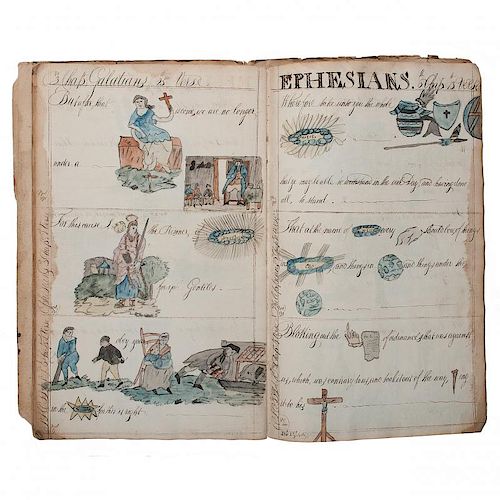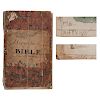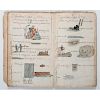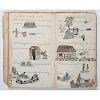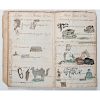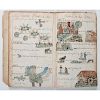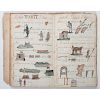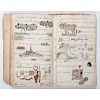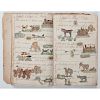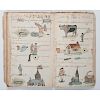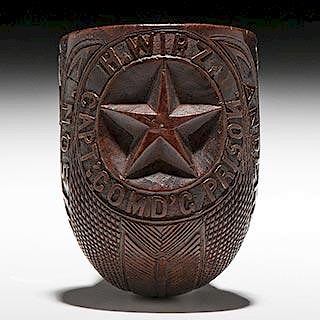Rare, Late 18th Century English Rebus Bible
About Seller
6270 Este Ave.
Cincinnati , OH 45232
United States
With offices in Cincinnati, Cleveland and Denver, Cowan’s holds over 40 auctions each year, with annual sales exceeding $16M. We reach buyers around the globe, and take pride in our reputation for integrity, customer service and great results. A full-service house, Cowan’s Auctions specializes in Am...Read more
Two ways to bid:
- Leave a max absentee bid and the platform will bid on your behalf up to your maximum bid during the live auction.
- Bid live during the auction and your bids will be submitted real-time to the auctioneer.
Bid Increments
| Price | Bid Increment |
|---|---|
| $0 | $25 |
| $500 | $50 |
| $1,000 | $100 |
| $2,000 | $250 |
| $5,000 | $500 |
| $10,000 | $1,000 |
| $20,000 | $2,500 |
| $50,000 | $5,000 |
| $100,000 | $10,000 |
About Auction
Feb 21, 2017 - Feb 22, 2017
Cowan's Auctions dawnie@cowans.com
- Lot Description
Anonymous. The Hieroglyphick Bible, III Edition. 8 x 12.75 in. copy book/journal, likely kept by an English seaman, late 18th century. 46 leaves (92 pp), marbled paper boards. Each page has three (one page with four) selected verses from the King James Bible. The verses are identified along the left or top margins. Each verse is illustrated in rebus form, with many small watercolors throughout. A conservative count of just the Old Testament portion yields a count of over 630 images.
Flayderman apparently acquired this while researching his book, Scrimshaw and Scrimshanders: Whales and Whalemen (New Milford, CT, 1972). Each right hand page has "HKL Fgs" (with a common vertical between H and K) and a number at the bottom after each, possibly the author's initials? Besides each verse being noted, each also has initials and a sequential number, beginning with 364. There are 275 verses (one page with 4, one with 1, the rest with 3), thus the verses are numbered to 639.
This author was no ordinary seaman, however. In the book, especially the first half, God is represented by a disk with rays extending outward, and "Domini" (Latin) within the oval. Later the disk has the Greek letters for "Theos" and at the end, generally the disk has the Hebrew letters for "YHWH;" there are "Hebrew disks" sprinkled through the first part, however (I Samuel 17:45 has both Latin and Hebrew forms, as do a few others). The text portion is in a very neat hand. His walled towns are reminiscent of the "Nuremberg Chronicle" (Liber Chronicarum) woodcuts. All indications are that the maker was well-educated. We would suggest he may have been a chaplain or surgeon on the vessel, or perhaps a missionary setting out to save some souls.
The first 47 pages contain Old Testament verses. The last 33 pages cover the New Testament. Somewhat surprisingly, the middle 12 pages contain verses from the Apocrypha (2 Esdras, Tobit, Judith, Wisdom of Solomon, Ecclesiasticus [Wisdom of Sira], Baruch, Bel & the Dragon, Maccabees [1 & 2]).
While there is no date, there are at least two coins with George III as well as the date of 1796. The military uniforms and styles of civilian clothing, as well as instrument forms all converge on the late 18th century as the most probable date for this Bible.
A wonderful piece of English folk art that certainly has more stories to tell than the ones suggested here. For example, in the verse Job 29: 15 ("I was eyes to the blind, and feet to the lame.") the artist portrays a man with a cane and dog as the rebus for "the blind." Many histories of guide dogs only trace them to post-WWI. However, there are mentions of guide dogs as early as the 16th century in English literature, and they are possibly depicted in an even earlier mural dating from the first century AD Herculaneum. The choices made for the verses and rebuses within them would be interesting in itself. Some bring a smile: in the verse from Galatians 6:11, his rebus for "letter" is a folded lettersheet with a red wax seal that is addressed "To the Galatians." Every "trip" through reveals new perspectives.
Flayderman and Marian Klamkin (1926-2012), a noted author of a number of books on topics ranging from White House china to folk sculpture, Shaker art, and more, made some attempts to publish this in the 1970s, with Flayderman revisiting the issue again in the 1980s and as late as 2002 - with the rise from one of Klamkin's proposals in the file included with the Bible:
This journal, a biblical rebus, has never, until recently, been seen outside of the New Bedford family in whose possession it has been for many generations. A rebus, by the way, is an enigmatical representation of words by pictures. The journal is a collection of verses from the Old and New Testament and possibly was written as a gift for a child. It is one of the most charming and effective examples of an eighteenth century hand-written and -illustrated journal that one could imagine.
...Instead of using illustrations that would relate to biblical times, the British sailor who devised and wrote this bible puzzle used contemporary eighteenth century figures, buildings, tools, musical instruments, uniforms, coins and other objects that would be familiar to anyone who attempted to untangle the puzzle....
"Seaman X", the author of this ingenuous Book of Hours, has left many hints throughout his journal as to when it was written and illustrated....Although the journal was written on a blank ledger of the type that was commonly used for nautical journals in the eighteenth century, the closest evidence we can find that the artist was a sailor is his remarkable understanding of how eighteenth century sailing ships were rigged and his frequent use of other objects familiar to the seaman. However, more research is needed to prove beyond any doubt that the rebus is, indeed, a sea journal.
The making of sea journals was a common pastime of sailors. As opposed to ship's logs, which make rather boring reading for anyone but the most dedicated marine historian, sailor's journals often contained poetry, maxims and random thoughts of the homesick sailor. They were seldom written with any real plan and some record information about ports visited, unusual geological elevations or ship repairs. Therefore, in respect to other sea journals of the period, this biblical rebus is unique. Its author obviously had more talent for drawing and painting than he did for writing and he probably chose verses from the Bible that he felt would more easily adapt to the rebus form.
She goes on to note that this should be printed with annotations, including explanations as to the choice of representative objects in historical perspective, a task to be undertaken by Flayderman and herself. Letters in the file indicate that this proposal was turned down by a couple of publishers.
Provenance: N. Flayderman and Co., Inc.
Condition
Water stain along right margin. Does not impact most verses, but does occasionally make the Chapter and Verse difficult to read on the left pages. Lower page edges slightly wrinkled from dampness, but no staining. Cover detached and spine (saddle stitched) nearly separated, but still present.
- Shipping Info
-
SHIPPING. At the request of the buyer, Cowan's will authorize the shipment of purchased items. Shipments usually occur within two weeks after payment has been received. Shipment is generally made via UPS Ground service. Unless buyer gives special instructions, the shipping method shall be at the sole discretion of Cowan's Auctions, Inc.. Cowan's is in no way responsible for the acts or omissions of independent handlers, packers or shippers of purchased items or for any loss, damage or delay from the packing or shipping of any property.
-
- Buyer's Premium



 EUR
EUR CAD
CAD AUD
AUD GBP
GBP MXN
MXN HKD
HKD CNY
CNY MYR
MYR SEK
SEK SGD
SGD CHF
CHF THB
THB